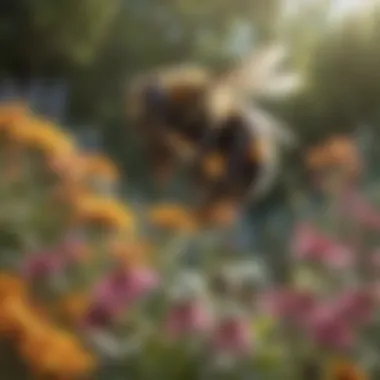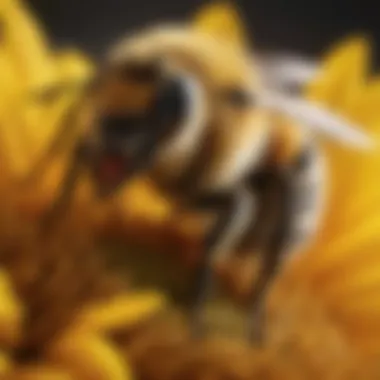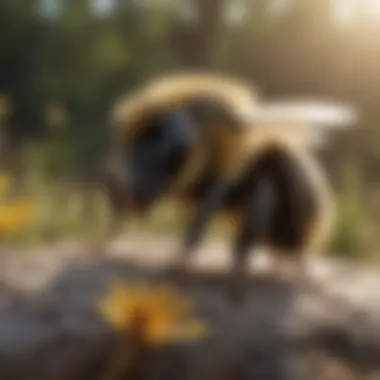Understanding Bumble Bees: Behavior and Management


Intro
Bumble bees play a crucial role in our ecosystems. Their presence around our homes often generates both curiosity and concern. Understanding their behavior, particularly swarming, is essential for coexistence. This article aims to explore the complexity of bumble bee behavior while providing insights on how to manage their activities around human dwellings.
Fascinating Facts About the Animal
Bumble bees exhibit remarkable traits that set them apart from other bee species. They are larger and fuzzier, attracting attention not only for their appearance but also for their amazing capabilities.
Unique Characteristics
One striking characteristic of bumble bees is their ability to regulate their body temperature. Unlike many insects, they can generate warmth through muscle movement. This ability allows them to maintain a stable internal temperature, essential for their activity in cooler climates.
Another unique feature is their social structure. Bumble bees are social insects that live in colonies. These colonies can range from 50 to 400 individuals, depending on the species. Each colony operates with a queen, workers, and drones, showcasing an intricate social hierarchy.
Extraordinary Abilities
Bumble bees possess an extraordinary ability to pollinate flowers effectively. Their size and hairy bodies enable them to carry a significant amount of pollen, making them exceptional pollinators. They often engage in a behavior called
Prologue
Understanding the behavior of bumble bees, particularly regarding swarming, is critical for homeowners, environmentalists, and anyone interested in biodiversity. This article delves into the biological and ecological aspects that influence bumble bee behavior, specifically in residential contexts. With rising concerns about biodiversity loss and the decline of pollinator populations, it becomes imperative to not only recognize the value of bumble bees but also to manage their interactions with human habitats effectively.
Bumble bees play an indispensable role in pollination, contributing to the health of ecosystems and the productivity of agricultural crops. Recognizing their importance helps foster a sense of appreciation, which is the first step towards coexistence. The nuances of bumble bee swarming, their attraction to specific nesting sites, and their reproductive cycles offer insight into their natural behaviors. Understanding these aspects aids homeowners in developing strategies that minimize conflict while maximizing ecological benefits.
Additionally, exploring the implications of swarming behavior helps address common concerns associated with bumble bees near residences. Many people fear swarms without understanding their context or significance. This knowledge serves to promote informed decision-making and responsible management practices.
As we explore this topic further, it is essential to appreciate the complexity of bumble bee ecology and the interrelated factors that drive their behavior. Through this discussion, readers will gain a comprehensive understanding of bumble bees, equipping them with the insights necessary for constructive engagement with these vital pollinators.
The Role of Bumble Bees in the Ecosystem
Bumble bees are essential contributors to the health of our ecosystems. They pollinate a variety of wildflowers, fruits, and vegetables. This role not only sustains plant populations but also supports the entire food web. Without functioning pollinators, many plants would struggle to reproduce.
- Pollination: Bumble bees facilitate the reproduction of plants by transferring pollen from one flower to another, enabling fertilization.
- Biodiversity: Their activity promotes the growth of diverse plant species, which creates habitats for other organisms and enhances biodiversity.
- Agricultural Benefits: Farmers benefit significantly from bumble bees, as they boost crop yields, particularly for species that demand effective pollination.
Understanding the role of bumble bees in maintaining ecological balance is crucial. Their presence indicates a healthy ecosystem, and protecting them should be a priority for communities.
Understanding Swarming Behavior
Swarming is a natural behavior seen in bumble bees, typically occurring during specific seasons. This behavior is linked to the lifecycle of the colony. Various factors contribute to why bumble bees decide to swarm, including overcrowding in the nest, the search for new nesting sites, and reproductive needs.
- Nesting Dynamics: As colonies grow, the existing nest may become insufficient for the population. Swarming can serve as a solution to alleviate crowding.
- Seasonal Timing: Most swarming events happen in the late spring to summer months when the primary reproductive cycle is underway, and environmental conditions are favorable.
- Colony Lifespan: Bumble bee colonies are annual, and as they approach their lifecycle's end, swarming occurs to ensure the continuation of their species.
Understanding these dynamics is vital for homeowners, as it can demystify the behavior of bumble bees. Recognizing when swarming may occur helps in preparing for and managing these events appropriately.


What Causes Bumble Bees to Swarm?
Understanding the causes of bumble bee swarming is crucial for homeowners and anyone interacting with these important pollinators. Swarming is a natural process in their lifecycle and occurs under specific circumstances. Knowing the triggers can help in managing the presence of bumble bees while minimizing potential issues. This insight is not only valuable for bee enthusiasts but also for those concerned about safety and possible damage to property.
Seasonal Factors Influencing Swarming
Bumble bees typically swarm during the warmer months, specifically late spring to early summer. The changing weather and longer daylight hours stir activity within the colony. As temperatures rise, the demand for nesting sites increases. This is often linked to resource abundance; flowers bloom, providing adequate forage. The new queens emerge, and they begin to look for a suitable place to establish their colonies. This seasonal rhythm is vital to the lifecycle of bumble bees and directly influences their movement patterns.
During the late spring, colonies reach their peak size, which coincides with the maturation of new queens. These queens may leave the nest to form new colonies. As the colony becomes overcrowded or senses environmental pressures, swarming is triggered. Heat, food scarcity, and competition can all stimulate this behavior.
Factors Related to Nesting Sites
Nesting sites play a significant role in the swarming behavior of bumble bees. Bumble bees prefer to nest underground, often in abandoned rodent burrows or shallow holes. However, they can also occupy more unusual spaces, like under decking or in piles of leaves. If these sites become compromised or filled with moisture, the bees may feel compelled to swarm in search of a more suitable habitat. Saturated nesting areas or disturbances from humans can catalyze the need to move to a new location.
The availability and quality of potential nesting sites become increasingly critical as the season progresses. When many queens emerge simultaneously, they compete for limited resources. This competition can lead to an increase in swarming activities as they disperse to seek new territories. Adequate nesting options are essential for sustaining the population more broadly.
Colony Dynamics and Reproduction
At the heart of swarming is the reproductive strategy of bumble bee colonies. As the summer approaches, the royal eggs—those that develop into new queens—are laid. This is a crucial time when reproductive pressures increase. The current queen may initiate swarming to reduce competition and to ensure her genetic line continues.
As the colony prepares for mating, drones are frequently produced alongside new queens. Drones are males whose primary role is to mate with emerging queens during their nuptial flights. After mating, the queens will search for a new nesting site, while the drones usually die shortly after. This lifecycle dynamic underscores the significance of swarming.
In summary, the causes of bumble bee swarming are multifaceted. Seasonal changes, nesting preferences, and colony reproductive strategies all interconnect to dictate when and how bees swarm. A deeper understanding of these factors not only benefits beekeepers but also supports homeowners in fostering environments that allow for the sustainable coexistence with these essential pollinators.
Identifying Bumble Bees
Identifying bumble bees is a crucial aspect of understanding their behavior and effective management. Bumble bees play an essential role in pollination, and being able to identify them can significantly influence how one approaches their presence around the home. Accurate identification helps in distinguishing them from other bees, which is important for safety and management strategies. Knowing specific characteristics aids in recognizing beneficial bumble bees, allowing people to appreciate the ecological value they bring.
Physical Characteristics of Bumble Bees
Bumble bees have distinct physical features that set them apart from other insects. They are generally larger than many other bee species, often characterized by a robust body covered in dense hairs. The main traits include:
- Coloration: Bumble bees typically display black and yellow bands, although some species may have orange or even white on their bodies.
- Size Variation: Their size ranges from about 1/2 inch to just over an inch in length. Certain species, like the common eastern bumble bee, are notably larger.
- Shape: A bumble bee's body shape is usually round or oval, contributing to its stout appearance.
These features are not only fascinating but also functional. The dense hair on their bodies assists in pollen collection, making them highly efficient pollinators. Understanding these characteristics helps homeowners recognize bumble bees more easily, promoting effective management and coexistence strategies.
Differentiating Bumble Bees from Other Bees
Differentiating bumble bees from other bee species is essential for accurate identification and ensuring proper management. Bumble bees can often be confused with honey bees and other solitary bee species. Key differences include:
- Behavior: Bumble bees are generally more docile than honey bees, especially when not provoked. They often forage alone rather than in large groups.
- Nesting Habits: Bumble bees typically build nests underground or in dense grass. Honey bees, on the other hand, form large colonies in hives or tree cavities.
- Appearance: While honey bees have a more slender build and a flatter body, bumble bees are larger and fluffier. Notably, bumble bees have a more pronounced fuzzy coat, which aids in their foraging activities.
Understanding these distinctions enhances awareness about the type of bees present in your area, contributing to safer interactions and informed decisions regarding bee management.


Emphasizing the correct identification of bumble bees enriches the ongoing dialogue about pollinators while also addressing safety concerns for homeowners.
The Impact of Swarming on Homeowners
Bumble bee swarming can create a complex situation for homeowners. While these insects play a crucial role in pollination and maintaining ecological balance, their presence can lead to various concerns. Understanding the impact of swarming not only guides how individuals react but also ensures harmony between human needs and ecological health.
Health and Safety Concerns
Health and safety are primary concerns for homeowners encountering bumble bee swarms. Although bumble bees are generally not aggressive, their swarming behavior can provoke fear. This fear often stems from a lack of understanding about their behavior.
While the risk of bee stings is evident, it’s essential to recognize the rarity of aggressive encounters. Most swarms are focused on relocating rather than confrontation. However, individuals with allergies to bee stings face significant risks. Therefore, awareness is critical.
Homeowners should take a few precautionary measures:
- Educate themselves: Understanding bumble bee behavior helps reduce fears.
- Maintain distance: Staying away from swarms minimizes the chances of stings.
- Seek professional advice: Consulting an expert for identification and management can prevent mishaps.
Response Strategies for Homeowners
Understanding how to effectively manage the presence of bumble bees around your home is crucial. Homeowners need to recognize the importance of these pollinators while also implementing strategies that ensure both safety and coexistence. The right response strategies can mitigate any concerns homeowners may have about swarms, without harming the bees.
Observation and Identification
Observation is the first step in managing bumble bees. Homeowners should take the time to watch the behavior of the bees. Is it a large group moving in a specific direction, or are they hovering around a specific area? Identifying the type of bumble bee can also help. Bumble bees are generally larger than honeybees and have a characteristic fuzzy appearance. Recognizing their distinctive markings and behaviors can help in understanding their activities and needs.
Moreover, understanding their nesting habits is important. Bumble bees prefer to nest in undisturbed areas, such as under decks, in tall grass, or even in abandoned rodent burrows. If you see bees consistently entering or exiting a small hole or cavity, it is likely a nest. Maintaining a distance during observation is advised, especially if the bumble bees seem agitated. Homeowners should keep children and pets away from the area to avoid any potential stings.
When to Seek Professional Help
It is sometimes necessary to call in a professional. If bumble bees are swarming aggressively or if you find a nest in an area where it poses a risk to inhabitants, do not hesitate to seek expert assistance. Professionals can evaluate the situation and determine if relocation of the bees is the best solution. This is especially important for nests that are located in high-traffic areas, such as near doorways or children's play areas.
Additionally, if someone in the household is allergic to bee stings, immediate professional intervention is critical. Homeowners also must realize that not all bees are harmful. In many situations, simply allowing the bees to exist undisturbed may be the best course of action.
It is essential to respect bumble bees, understanding they play a significant role in the ecosystem while ensuring safety for your family.
Safe Practices for Coexistence
Understanding how to coexist with bumble bees is crucial, especially in residential areas where swarming can occur. Bumble bees play a significant role in pollination and contribute to the health of the ecosystem. Therefore, safe practices can help mitigate human-wildlife conflicts while promoting environmental stewardship.
A key benefit of establishing safe practices is the reduced risk of stings and other potential health issues. By taking proactive measures, homeowners can help ensure that bumble bees are not unnecessarily disturbed or attacked, thereby promoting a peaceful coexistence. Additionally, these practices foster public awareness about the ecological importance of these bees, encouraging respect and admiration.
Another consideration is the educational aspect: educating family members, especially children, about bumble bee behavior can instill a sense of understanding and patience. It helps demystify their presence and transforms fear into appreciation.
Good practices can transform how communities view these vital pollinators.


Creating a Bee-Friendly Environment
Creating a bee-friendly environment is about fostering a habitat that is supportive of bumble bees. Simple measures can have a significant impact. Start by planting a diverse range of flowers that bloom at different times throughout the year. This approach provides continuous food sources for bumble bees. Native plants are especially good choices, as they are adapted to local ecosystems and attract native pollinators.
Avoid chemical pesticides and herbicides. These chemicals can harm bees and other beneficial insects. Instead, opt for organic gardening methods that promote natural pest control. An inviting landscape could also consist of bare ground areas for nesting or maintaining patches of undisturbed grass.
Consider adding water sources, such as shallow dishes filled with pebbles and water. This can help bumble bees stay hydrated, especially in hotter months. By offering these small amenities, homeowners can make their environment much more appealing to bumble bees.
Mitigating Risks Without Harm
Mitigating risks without harm involves a balanced approach to dealing with the presence of bumble bees. First, educate yourself and family members about bumble bee behavior. Recognizing that swarming is often temporary helps reduce panic. It is also essential to learn about specific times when bumble bees are more active, like during warm afternoons.
If bumble bees decide to nest nearby, consider observation instead of immediate removal. Many swarming events resolve within a short period, and the best choice may simply be to let them be. If the bees pose a risk to heavily trafficked areas, contacting a local beekeeper or pest control expert who specializes in bee relocation can be an effective solution.
In case of stings, it is beneficial to have a basic first aid kit on hand. This kit should include antiseptic wipes and various band-aids. Understand the best practices for treating minor stings and recognize when to seek medical advice. This knowledge can help manage incidents effectively, contributing to a safer home environment.
By implementing these practices, homeowners can minimize risks while promoting an ecosystem that thrives. This understanding not only enhances the safety of individuals but also nurtures a community where bumble bees can live and flourish.
The End
The Importance of Bumble Bees
Bumble bees play a vital role within the ecosystem. Their contributions extend beyond simple beauty; they are key pollinators for numerous flowering plants. This process is essential for the reproduction of many crops and wild plants. Without their activity, food production could significantly decline, affecting various species and overall biodiversity. Choosing to understand these insects allows homeowners to appreciate their importance, fostering a healthy and balanced ecosystem around us.
Additionally, understanding how bumble bees operate can mitigate fears associated with their swarming behavior. Their swarming is commonly misinterpreted as aggressive when, in reality, it is often related to colony dynamics and environmental factors. By recognizing this, people might reduce unnecessary fears and take appropriate steps in managing their presence, leading to a harmonious coexistence.
Final Thoughts on Swarming Management
As discussed, swarming behavior can be perplexing to many homeowners. However, understanding the factors behind it provides valuable insights into how to manage these events safely. The priority should always be on coexistence, balancing human concerns with the need to protect our environment. The use of safe practices, such as creating bee-friendly habitats and adopting non-invasive observation techniques, can reduce the chance of conflict.
Importance of References
Credibility and Trustworthiness
A comprehensive reference section enhances the credibility of the article. When readers see citations from reputable sources, they can trust the accuracy of the information. This is especially crucial in a subject like bumble bee behavior, where scientific understanding is continually evolving.
Encouraging Further Research
References allow interested readers to dig deeper into specific topics. By including links to academic journals, articles, and studies, the article serves as a springboard for further research. This can be particularly beneficial for veterinarians, wildlife biologists, and families wanting to learn more about bumble bee management.
Broader Context
The references help place the article within the larger context of biodiversity and ecological studies. They inform readers not just about bumble bees but also about their role within larger ecosystems, conservation efforts, and habitat management practices.
"To understand the full scope of bumble bee behavior and management, one must look beyond the surface, including a variety of scholarly resources."
Considerations
When compiling the references, it is essential to include a mix of primary research articles, reviews, and accessible resources like encyclopedic entries. This variety ensures a comprehensive understanding and caters to readers with diverse backgrounds.







